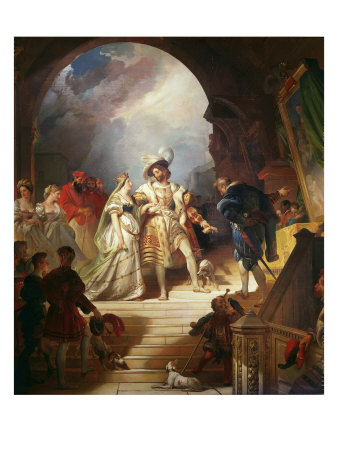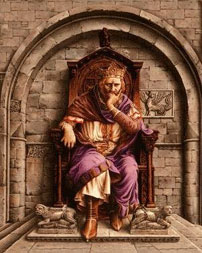I first want to start off my apologizing for my brief absence. I'm in the middle of studying for finals and have been very busy with school; therefore, I'm behind on my reviews and I want to explain and apologize. Finals will be over on Thursday and I hope to catch up soon after they are over and done with.
In light of my up coming review of To Serve A King by Donna Russo Morin, I have decided to re-post Donna's guest post on King Francois I. Enjoy!
I am so pleased to welcome Donna Russo Morin author of To Serve a King, to All Things Historical Fiction. She is here to discuss the remorse and redemption of King Francois I of France. Be on the look out for my review of To Serve A King in the next couple of weeks along with the chance to win a copy!
The Remorse and Redemption of a King and his Court
François I reigned in France during the same era in which Henry VIII ruled England. When I found him in my research for a previous novel, I was struck by what he and I had in common: in the realm of historical fiction, the Tudor stories tend to be a bit more popular than those set in other European countries, like mine. And while François was not only more powerful and contributed more to the world, he has always taken a back seat to Henry in terms of the history of the period. These two kings, along with Charles V of Spain, were constantly trying to outdo and overthrow the other. In that, I found the context for my story.
For a king who was rarely portrayed in historical fiction, and then only as a supporting character, I found great depth in this ruler often referred to as the Renaissance Warrior. His mother, Louise de Savoy, fought the courts to raise François, his sister, and the children of her recently deceased husband’s mistress. She emerged victorious, and with a loving and disciplined hand, raised them all as her own. François was surrounded by women for most of his childhood and adolescence, and his empathy for the feminine sensibility would color the rest of his life. These women, especially his mother and sister, were intelligent, educated, and sophisticated; they exposed him to the very best in art, literature and music that the late Renaissance had to offer and he would later dedicate his life to the artistic enrichment of his country. Few other rulers can compare in leaving a more notable and lasting cultural legacy than François I. By establishing the Lecteurs Royaux in 1530, François laid the foundation for the Collège de France. His compilation of books evolved into the Bibliotheque Nationale. And, most noteworthy of all, his trove of art became the nucleus of the world famous collection now held at the Louvre.
When writing François I, I was not unmindful or blind to his brutish youth, however I was deeply aware of the personal hardships he had encountered—the loss of spouse, the loss of beloved children, the slow torture of watching his own power diminish as he aged. In the major biographies read during my research, I found a great dichotomy between his early years and those in his latter days. I was struck by the notion, and the hope, that we have the ability to become truly conscious beings and in the clarity of vision such consciousness affords, we can look back and see the road behind us with all its potholes and wrong turns. It is distasteful to have regrets—the acidity sticks in the craw and repeats offensively—but if conscious of their power as tools, the enlightened can use them to find remorse, and it is in remorse that we are redeemed. Thus was how I found François; it is how I wrote him. I can say with certainty there was a wish in such a rendering.
 In this book, as in my first two books (The Courtier’s Secret 2/2009 and The Secret of the Glass 3/2010), there is always a subliminal theme which mirrors events or emotions taking place in my own life. To Serve a King is no different. I was going through one of the most challenging phases of my life while I was writing this book, so challenging in fact, I wasn’t sure I would get it written. And as happens for many people in such circumstances, overcoming the emotions of such challenges—anger and hate—is the true test. And so it is for my main character, Geneviève Gravois. To Serve a King is a story of intrigue, murder, passion and betrayal. But at its heart, it is a story of redemption.
In this book, as in my first two books (The Courtier’s Secret 2/2009 and The Secret of the Glass 3/2010), there is always a subliminal theme which mirrors events or emotions taking place in my own life. To Serve a King is no different. I was going through one of the most challenging phases of my life while I was writing this book, so challenging in fact, I wasn’t sure I would get it written. And as happens for many people in such circumstances, overcoming the emotions of such challenges—anger and hate—is the true test. And so it is for my main character, Geneviève Gravois. To Serve a King is a story of intrigue, murder, passion and betrayal. But at its heart, it is a story of redemption.
In light of my up coming review of To Serve A King by Donna Russo Morin, I have decided to re-post Donna's guest post on King Francois I. Enjoy!
I am so pleased to welcome Donna Russo Morin author of To Serve a King, to All Things Historical Fiction. She is here to discuss the remorse and redemption of King Francois I of France. Be on the look out for my review of To Serve A King in the next couple of weeks along with the chance to win a copy!
The Remorse and Redemption of a King and his Court
François I reigned in France during the same era in which Henry VIII ruled England. When I found him in my research for a previous novel, I was struck by what he and I had in common: in the realm of historical fiction, the Tudor stories tend to be a bit more popular than those set in other European countries, like mine. And while François was not only more powerful and contributed more to the world, he has always taken a back seat to Henry in terms of the history of the period. These two kings, along with Charles V of Spain, were constantly trying to outdo and overthrow the other. In that, I found the context for my story.
For a king who was rarely portrayed in historical fiction, and then only as a supporting character, I found great depth in this ruler often referred to as the Renaissance Warrior. His mother, Louise de Savoy, fought the courts to raise François, his sister, and the children of her recently deceased husband’s mistress. She emerged victorious, and with a loving and disciplined hand, raised them all as her own. François was surrounded by women for most of his childhood and adolescence, and his empathy for the feminine sensibility would color the rest of his life. These women, especially his mother and sister, were intelligent, educated, and sophisticated; they exposed him to the very best in art, literature and music that the late Renaissance had to offer and he would later dedicate his life to the artistic enrichment of his country. Few other rulers can compare in leaving a more notable and lasting cultural legacy than François I. By establishing the Lecteurs Royaux in 1530, François laid the foundation for the Collège de France. His compilation of books evolved into the Bibliotheque Nationale. And, most noteworthy of all, his trove of art became the nucleus of the world famous collection now held at the Louvre.
When writing François I, I was not unmindful or blind to his brutish youth, however I was deeply aware of the personal hardships he had encountered—the loss of spouse, the loss of beloved children, the slow torture of watching his own power diminish as he aged. In the major biographies read during my research, I found a great dichotomy between his early years and those in his latter days. I was struck by the notion, and the hope, that we have the ability to become truly conscious beings and in the clarity of vision such consciousness affords, we can look back and see the road behind us with all its potholes and wrong turns. It is distasteful to have regrets—the acidity sticks in the craw and repeats offensively—but if conscious of their power as tools, the enlightened can use them to find remorse, and it is in remorse that we are redeemed. Thus was how I found François; it is how I wrote him. I can say with certainty there was a wish in such a rendering.




















